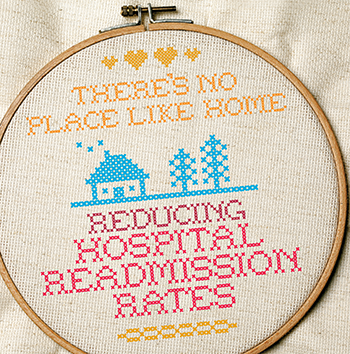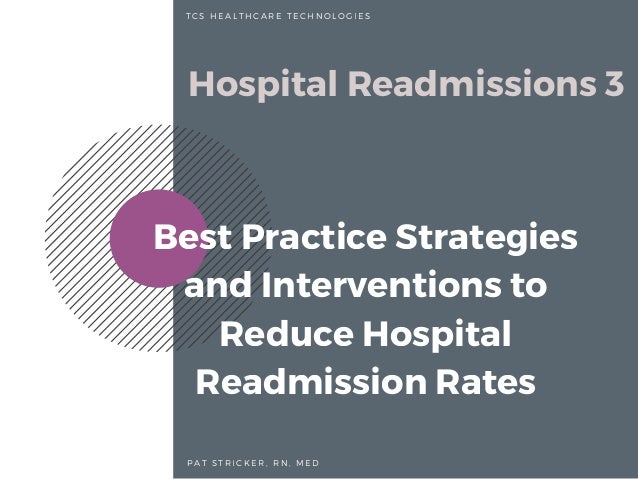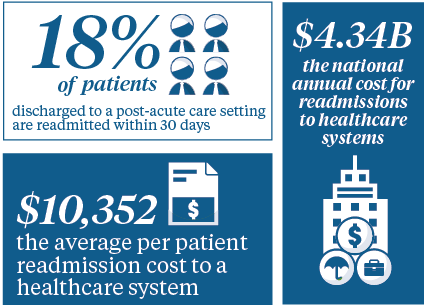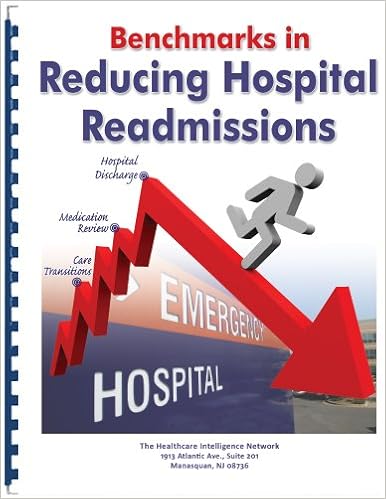The goals of the guide are to provide. Postacute care providers are undertaking widespread and intense efforts to reduce them.
 Reducing Hospital Readmissions Saving Medicare Dollars Long Term Care Leader
Reducing Hospital Readmissions Saving Medicare Dollars Long Term Care Leader
Mobilizing Skilled Nursing Facilities to Reduce Avoidable Rehospitalizations.

Preventing hospital readmissions. Unplanned hospital readmission is not always related to the previous visit. Allina Health decided to focus on 30-day potentially preventable readmissions PPRs as its global outcome measurement. PHARMACISTS ROLE IN TRANSITIONS OF CARE RAJEEV KUMAR MD FACP CHIEF MEDICAL OFFICER SYMBRIA OBJECTIVES Identify elements of key literature that describes post-hospital medication discrepancies that result in adverse events Recognize changes in the hospital facility and physician payment structure.
In 2012 the Centers for Medicare Medicaid Services began reducing Medicare payments for certain hospitals with excess 30-day readmissions for patients with several conditions. Preventing readmissions among minority populations. Research validates that access to physical therapy can prevent or reduce the risk of readmissions.
Preventing Readmissions Resources and Tools To Improve Discharge and Transitions of Care and Reduce Readmissions The Agency for Healthcare Research and Quality supports research on the quality and safety of the hospital discharge process and care transitions. Readmissions are defined as subsequent hospital admission for any cause within 30 days following an initial hospital admission referred to as the index stayFingar Washington 2015. This article summarizes the evidence related to decreasing readmission for patients with heart failure within 30 days after discharge focusing on the acute setting.
It is important to know the average number of days that patients spend in a hospital for the most commo. An overview of key issues related to disparities in readmissions A set of activities that can help hospital leaders address readmissions in this population Strategies aimed at reducing readmissions in diverse populations. Reducing 28-day or 30-day readmissions has become an important aim for healthcare services spurred in part by the introduction of financial incentives for hospitals with high readmission rates in the USA England Denmark Germany and elsewhere1 Unfortunately many of the most effective interventions are costly since they are multimodal and involve several components and multiple.
What happens when hospitals and health systems look beyond to the non-clinical issues upstream that have a big impact on rehospitalizations. Allina Healtha 13-hospital health system serving Minnesota and Wisconsinbelieves that patients deserve to receive optimum follow-up care and support after discharge from the hospital thus minimizing readmissions. The cost of readmissions to the health care system is substantial accounting for an estimated 174 billion in spending annually by Medicare alone1 The Hospital Readmissions Reduction Program HRRP established in the Affordable Care Act12 authorizes Medicare to reduce payment to hospitals with excess readmission rates.
The Centers for Medicare and Medicaid Services CMS reports hospital readmission rates for Medicare patients who were admitted to the hospital for heart attack heart. Of course some readmissions are necessary due to complications bleeding infection or other non-foreseen event but there are also a lot of unnecessary readmissions that could have been prevented if some simple precautions had been taken. Each patient requires an individualized plan for successful transition from hospital to home and preventing readmission.
Improvements in these areas can lead to reductions in potentially avoidable readmissions. Reducing preventable hospital readmissions is a national priority for payers providers and policymakers seeking to improve health care and lower costs. Preventing readmissions for HF patients is an increasing priority for clinicians researchers and various stakeholders.
The following review will discuss the interventions found to reduce readmissions for patients and improve hospital performance on the 30-day readmission process measure. The goal of the HRRP is to reduce unplannedunnecessary hospital readmissions within 30 days of discharge. RAR T AUE PSICA TRAPY Excessive hospital readmissions are under scrutiny for their cost and negative impact on patient outcomes.
October 25 2018 Initiatives to reduce avoidable readmissions are the norm in US health systems today. Readmission to the hospital could be for any cause such as worsening of disease or new conditions. Of readmissions to hospital post-acute care.
 How To Reduce Hospital Readmissions Ephraim Zagelbaum
How To Reduce Hospital Readmissions Ephraim Zagelbaum
 Readmission Reduction Program 10 Must Do Steps
Readmission Reduction Program 10 Must Do Steps
 There S No Place Like Home Reducing Hospital Readmission Rates Apta
There S No Place Like Home Reducing Hospital Readmission Rates Apta
 Best Practice Strategies And Interventions To Reduce Hospital Readmis
Best Practice Strategies And Interventions To Reduce Hospital Readmis
 Post Acute Care Med1healthcare
Post Acute Care Med1healthcare
 Family Consultation To Reduce Early Hospital Readmissions Among Patients With End Stage Kidney Disease American Society Of Nephrology
Family Consultation To Reduce Early Hospital Readmissions Among Patients With End Stage Kidney Disease American Society Of Nephrology
 3 Strategies To Reduce Hospital Readmission Rates Costs
3 Strategies To Reduce Hospital Readmission Rates Costs
 Reducing Hospital Readmissions Mckesson
Reducing Hospital Readmissions Mckesson
 Can Digital Social Tools Reduce Hospital Readmissions
Can Digital Social Tools Reduce Hospital Readmissions
Resources For Preventing Hospital Readmissions The Bulletin
 Unplanned Hospital Readmission After Cranial Neurosurgery Operative Neurosurgery
Unplanned Hospital Readmission After Cranial Neurosurgery Operative Neurosurgery
 Reducing Hospital Readmissions The Value Of Analytics
Reducing Hospital Readmissions The Value Of Analytics
 Benchmarks In Reducing Hospital Readmissions Compilation Patricia Donovan Jane Salmon 9781936186051 Amazon Com Books
Benchmarks In Reducing Hospital Readmissions Compilation Patricia Donovan Jane Salmon 9781936186051 Amazon Com Books
 Top Factors In Decreasing Hospital Readmission Rates
Top Factors In Decreasing Hospital Readmission Rates
No comments:
Post a Comment
Note: Only a member of this blog may post a comment.